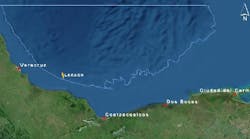Leonard Le Blanc
Editor
Seven new gas pipelines in the US Gulf of Mexico are stretching to gather deepwater gas reserves. Over 40 additional deepwater commercial oil discoveries are awaiting development decisions, many of which have associated gas that will have to be transported back to shallow water.Three unalterable events are converging to drive the developing deepwater natural gas play and pipeline expansion in the US Gulf of Mexico:
- No gas, no oil - Deepwater crude oil production will double within the next three to five years and producers must find a way to move the associated gas to market. Flaring is not an option, injection is some cases is cost prohibitive or not technically feasible, and liquids conversion technology is not sufficiently advanced.
- Declining reserves - Through 1995, natural gas reserves had dropped over 40% in the US Gulf since 1989, and would have been as high as 60% had not large new gas discoveries off Alabama been added. Since gas throughput has not declined proportionally, and Gulf of Mexico gas fields have an average production life of five years, transporters are in danger of having gas throughput collapse several years out, stranding pipeline investments and supply commitments. Hence, there is a great interest in attaching deepwater gas production.
- Electricity deregulation - Gas prices will be supported in the near term by two major economic events. Much of the US's aging power generation capacity will be replaced eventually with low-cost combined cycle gas turbines. Also, US power generating companies and gas producers and transporters are racing to acquire one another in anticipation of power deregulation.
As fast as new discoveries turn up in deepwater, gas pipelines will extend from the existing infrastructure along the outer edge of the continental shelf to bring that gas ashore. There are only economic, not technical, limits to installing that capacity.
Bringing it ashore
The first concern about deepwater oil several years ago - how much gas was there - has been answered. Gas volumes there are significant, but more is associated than free at this time, with oil-gas ratios as high as 50:50 (Ram Powell). The second concern - can it be transported competitively - is being answered now. In many cases, and especially now that US gas prices average above $2/Mcf, the production of associated gas simply pushes the margin of profitability up for deepwater oil fields. In others, especially in ultra-deepwater, operators will have no choice but to inject the gas or lay the lines if they want to produce the oil.
Several methods of natural gas conversion to liquids using a sequence of catalysts have been developed and are considered commercial at current oil prices, but the technology lacks field experience. Developers cannot await the three to four year trial period.
The first series of gas pipelines in deepwater proposed within the last year are not a significant challenge, either economically or technically. In fact, one of Shell?s proposed gas pipelines was over-subscribed in the proposal stage. The next series, reaching into depths beyond 5,000 ft, may be much more challenging.
Adding 7 Bcf/d
US Gulf projections made by the IEA call for an additional 7 Bcf/d of gas to be produced and transported by operators in deepwater by the year 2005, assuming that drilling units are available for the development work.
This is a 63% increase over current production. Gas production coming from the entire Gulf, including Mobile Bay, totals only about 12.3 Bcf/d.
This production rate is sufficient to last only seven years without new reserve additions, so the new deepwater additions are very important for the future of gas throughput in the US Gulf. How will this new throughput be added? A series of pipelines have been installed or proposed by Shell and Texaco within the past year, and other operators are stepping in with other projects to link deepwater gas.
Central Gulf pipelines
Gas pipelines added recently and proposed by operators in the US Gulf include the following:
- Mississippi Canyon Gathering System (Shell) - This line, which began flowing in October of 1996, consists of a 45-mile, 30-in. trunkline from the shelf edge to Venice, Louisiana. A 14-in. lateral, the first of three, stretches 45 miles to connect Shell's Mars gas production with the end of the trunkline. Initial production was 400 MMcf/d (eventually 600 MMcf/d) from Mars. Two more laterals will be laid to connect gas production from Ursa (400 MMcf/d) and Mensa. Eventual production is expected to exceed 1.1 Bcf/d by 2000.
- Nautilus/Manta Ray System (Shell, Marathon, Leviathan) - This 30-in. trunkline stretches 87 miles from Green Canyon and ties into the existing Manta Ray pipeline. The Manta Ray pipeline, which goes ashore at Burns Point, Louisiana, will be upgraded for increased throughput. The Manta Ray line serves the Eugene Island, Ship Shoal, South Timbalier, Ewing Bank, and Green Canyon areas. Initial throughput will be 600 MMcf/d from the Troika field in Green Canyon, but reserves will be added from Bullwinkle and Pompano (tied back to Bullwinkle).
- Garden Banks Gathering System (Shell, Amerada Hess) - This 30-in., 50-mile trunkline will link gas production from Shell's Auger and Enchilada platforms to an interstate pipeline running laterally on the continental shelf. Initial throughput is 600 MMcf/d, but there will be capacity to double or triple throughput.
- Discovery System (Texaco) - This $350 million, 130-mile system and processing plant will transport and process onshore 700 MMcf/d of Texaco's gas from deepwater. The line will be available for additional throughput off central Louisiana.
- Green Canyon Gathering System (Tenneco Energy) - This 24-in., 153-mile dual lateral line will connect with gas production from the Green Canyon, Ewing Bank, Mississippi Canyon, Ship shoal, Grand Isle, and South Timbalier areas to an existing line in the South Timbalier area. Initial throughput will be 500 MMcf/d.
Eastern Gulf pipelines
In addition to pipelines off central and eastern Louisiana, several pipelines and additions have been proposed to bring gas off Mobile Bay, Alabama to shore. The lines have the capacity to link further discoveries in deepwater off Alabama and Florida.
- Dauphin Island Gathering System (PanEnergy, MCN Energy, Coastal, CNG, OED) - As of January 1, this pipeline was merged with the Main Pass Gathering System linking the Main Pass area (Blocks 223 and 225) and Viosca Knoll 826. The linkup will include 78 miles of 24-in. line to provide for an initial 500 MMcf/d throughput. Another 600 MMcf/d will be added by the end of 1997.
- Destin Pipeline (Shell, Amoco) - This $294 million, 36-in., 76-mile trunkline (additional 135 miles on land) will link Main Pass 260 to shore, adding 1 Bcf/d to Transco pipeline in central Mississippi. The line will also tap other reserves in the Mobile, Viosca Knoll, and Main Pass East areas.
Spare capacity
Shell Oil is spending $450 million to build it's three new natural gas pipelines to serve deepwater fields, and has set up a new business unit to handle and market gas. The unit is known as Shell Midstream Enterprises (SME).
SME is set up to handle risk and to build infrastructure where Shell does not have equity production. The new unit will manage capacity and will provide third-party production handling, natural gas processing, crude oil trading, offshore telecommunications, advice on property deals, and valuations.
A major reason for the new unit is because the lines will be owned by Shell and others and will sell 30% of capacity in the three new pipelines to other parties. Alone, Shell will move 2.2 Bcf/d by the year 2000.






